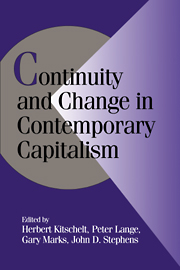Book contents
- Frontmatter
- Contents
- List of Contributors
- Preface
- Introduction
- PART I THE INTERNATIONAL SETTING FOR POLITICAL-ECONOMIC STRATEGIES
- PART II THE DYNAMICS OF DOMESTIC POLITICAL ECONOMIES
- 4 Divergent Production Regimes: Coordinated and Uncoordinated Market Economies in the 1980s and 1990s
- 5 The Political Economy of Europe in an Era of Interdependence
- 6 The Welfare State in Hard Times
- 7 Postwar Trade-Union Organization and Industrial Relations in Twelve Countries
- 8 Social Democratic Labor Market Institutions: A Retrospective Analysis
- 9 The Declining Significance of Male Workers: Trade-Union Responses to Changing Labor Markets
- PART III POLITICAL ECONOMY AND DEMOCRATIC COMPETITION
- PART IV CONCLUSION
- References
- Index
- Title in the series
8 - Social Democratic Labor Market Institutions: A Retrospective Analysis
Published online by Cambridge University Press: 05 June 2012
- Frontmatter
- Contents
- List of Contributors
- Preface
- Introduction
- PART I THE INTERNATIONAL SETTING FOR POLITICAL-ECONOMIC STRATEGIES
- PART II THE DYNAMICS OF DOMESTIC POLITICAL ECONOMIES
- 4 Divergent Production Regimes: Coordinated and Uncoordinated Market Economies in the 1980s and 1990s
- 5 The Political Economy of Europe in an Era of Interdependence
- 6 The Welfare State in Hard Times
- 7 Postwar Trade-Union Organization and Industrial Relations in Twelve Countries
- 8 Social Democratic Labor Market Institutions: A Retrospective Analysis
- 9 The Declining Significance of Male Workers: Trade-Union Responses to Changing Labor Markets
- PART III POLITICAL ECONOMY AND DEMOCRATIC COMPETITION
- PART IV CONCLUSION
- References
- Index
- Title in the series
Summary
The golden age of social democracy in western Europe in terms of both political prominence and economic performance might be dated as beginning in 1966, when the social democrats entered government in West Germany for the first time since 1930, and ending in 1974–1975, with the first serious slump of the postwar period. The high point of social democracy in terms of its academic reputation, however, was just beginning in 1974. During the 1960s and early 1970s, all of western Europe experienced steady growth and low levels of unemployment. Only after the first oil shock did dramatic cross-national differences in macroeconomic performance appear. In comparison to the steady rise of unemployment within the European Community in the late 1970s and 1980s, the maintenance of full employment in the European Free Trade Association (EFTA) countries – Norway, Sweden, Finland, Austria, and Switzerland – was striking. If Switzerland is removed from the list of good performers on the grounds that the Swiss maintained full employment by expelling guest workers, the correlation between any reasonable measure of social democratic strength and macroeconomic permanence was almost perfect. If one adds the impressive achievements in terms of comprehensive social insurance and, in Norway and Sweden, the extraordinary reduction of wage inequalities, the academic respect that social democracy enjoyed is easy to understand.
- Type
- Chapter
- Information
- Continuity and Change in Contemporary Capitalism , pp. 231 - 260Publisher: Cambridge University PressPrint publication year: 1999
- 6
- Cited by

